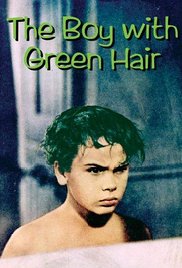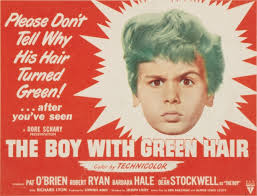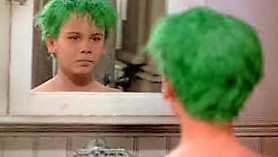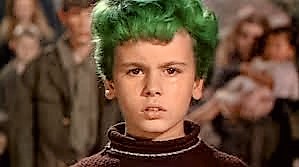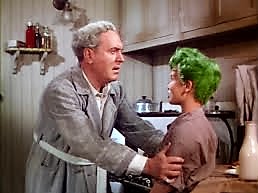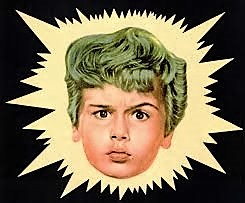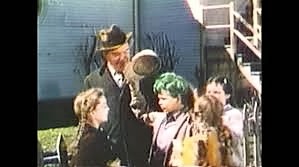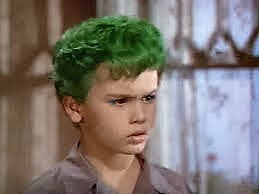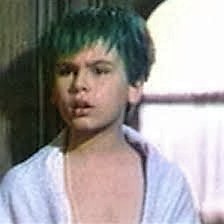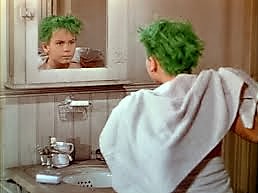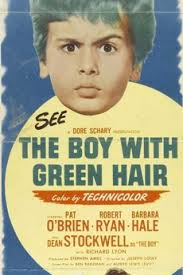The Boy with Green Hair **** (1948, Dean Stockwell, Pat O’Brien, Robert Ryan, Barbara Hale, Samuel S Hinds, Walter Catlett, Regis Toomey, Russ Tamblyn) – Classic Movie Review 4025
Director Joseph Losey’s heartwarming and intelligent 1948 parable story about being different and an outcast showcases a lovely winning performance from 12-year-old little Dean Stockwell as war orphan Peter Frye. Peter is a typical American kid who is rejected when his hair changes colour after his parents are killed during a Nazi air raid in the London Blitz.
The boy, who doesn’t know he has been orphaned, is moved from one selfish relative to the next, ending up with talkative, kindly ex-vaudevillean Gramp (Pat O’Brien). The morning after Peter learns that he is an orphan, his hair turns green, leading to ignorance and contempt from all the stupid prejudiced people around him.
The small-town police find a silent young runaway boy and call in a psychologist (Robert Ryan) and discover that he is a war orphan named Peter Frye, who tells his story to him, starting with being an orphan.
O’Brien, Robert Ryan as psychologist Dr Evans, Barbara Hale as Miss Brand, Samuel S Hinds as Dr Knudson, Walter Catlett as The King, and Regis Toomey as Mr Davis prove good and true actors as the main adults.
Losey’s distinguished feature directorial début, The Boy with Green Hair is a film that is a good advert for honest, liberal and decent virtues. It is also seen as an anti-war allegory, delivering the pacifist message that children are always victims in war. It is the kind of leftist film that could help get its maker into a lot of trouble in that era.
The conservative Howard Hughes took over the RKO studio while this film was being shot and tried to sabotage it. But Losey managed to protect the film’s integrity. Screenwriter Ben Barzman recalled: ‘Losey shot the picture in such a way that there wasn’t much possibility for change. A few lines were stuck in here and there to soften the message, but that was about it.’
Also notable in the cast are Richard Lyon, Charles Meredith, David Clarke, Billy Sheffield, Johnny Calkins, Teddy Infuhr, Dwayne Hickman, Eilene Janssen and Russ Tamblyn.
Ben Barzman and Alfred Lewis Levitt’s screenplay is based on the 1946 short story by Betsy Beaton.
Sadly, messages are for Western Union, and the film recorded a loss of $420,000 for RKO Radio Pictures.
The cast are Pat O’Brien as Gramp Frye, Robert Ryan as Dr Evans, Barbara Hale as Miss Brand, Dean Stockwell as Peter Frye, Richard Lyon as Michael, Walter Catlett as The King, Samuel S Hinds as Dr Knudson, Charles Meredith as Mr Piper, Regis Toomey as Mr Davis, David Clarke as Barber, Billy Sheffield as Red, Johnny Calkins as Danny, Teddy Infuhr as Timmy, Dwayne Hickman as Joey, Eilene Janssen as Peggy, Dale Robertson, William Smith and Russ Tamblyn as Classmate (uncredited).
The song ‘Nature Boy’, written by eden ahbez, is a primary theme. Nat King Cole’s version was number one on the Billboard charts for eight weeks in summer 1948.
It was released on 16 November 1948, but its UK release was held back until 19 June 1950.
The film runs 82 minutes and is shot in Three-Strip Technicolor by George Barnes.
Filming location: McKinley Home for Boys, 13840 Riverside Drive, Van Nuys, Los Angeles.
Losey joined the Communist Party in 1946. He had a long-term contract with producer Dore Schary at RKO when Howard Hughes bought the studio in 1948 and began purging it of leftists. In mid-1949, Schary persuaded Hughes to release Losey, who soon began working as an independent on The Lawless. Then his name was mentioned by two witnesses before the House Un-American Activities Committee in spring 1951. He settled in London on 4 January 1953.
Ben Barzman was also blacklisted by the House Un-American Activities Committee. He and his wife Norma also moved to England. Edward Dmytryk, one of the Hollywood Ten, testified about the Barzmans to HUAC in 1951. Norma Barzman recalled: ‘To get out of prison he named us and a lot of other people.’
Dean Stockwell plays Howard Hughes in Tucker: The Man and His Dream (1988).
Martin Scorsese plays an American film-maker named Joe Lesser, based on Joseph Losey, who leaves Hollywood for England rather than face HUAC investigations in Guilty by Suspicion (1991).
Stockwell and Tamblyn met each other on this film and became life-long friends. Stockwell is the godfather of his daughter Amber Tamblyn.
Stockwell was allergic to the green wig he had to wear and became ill.
The cue ring, or dot that indicates to the projectionist the time to change reels, is green instead of its usual black.
Stockwell replaced Gary Gray who caught chicken pox.
It is Tamblyn’s film debut.
© Derek Winnert 2016 Classic Movie Review 4025
Check out more reviews on http://derekwinnert.com

